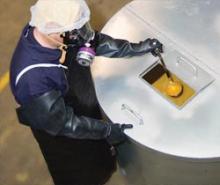Artificial Butter Flavorings (ABF) Components

Research Overview
Status: Completed
Substances:
2,3-Pentanedione (Acetyl Propionyl)
2,3-Butanedione (Diacetyl)
2-Hydroxy-3-butanone (Acetoin)
Nominated:
July 1994;
July 2006
Background Information
In 2000, eight employees at a microwave popcorn packaging plant were diagnosed with bronchiolitis obliterans—a rare lung disease characterized by fibrotic obstruction of the small airways. A subsequent NIOSH health hazard evaluation found that diacetyl and acetoin were the major volatile components of the artificial butter flavoring vapor to which microwave popcorn packaging workers were exposed. Diacetyl is a naturally occurring substance that gives butter its characteristic flavor and aroma, and is often a component of artificial flavoring formulations. Acetoin, a closely related chemical, also occurs naturally and is an ingredient in many flavoring formulations, perfumes and essences. Diacetyl and acetoin are present in almost all alcoholic beverages as fermentation products.
In 2007, artificial butter flavoring (ABF) and two major volatile constituents, diacetyl and acetoin, were nominated by the United Food and Commercial Workers Union for long-term inhalation testing for respiratory toxicity, general toxicity, and carcinogenicity. Because NIOSH was conducting studies of an artificial butter flavoring formulation, NTP research focused on diacetyl, acetoin, and related flavorings components.
NTP prepared a research concept in 2007. NTP studies on artificial butter flavorings and their components were designed to provide animal toxicity data needed by regulatory agencies to set inhalation exposure limits that will protect workers. The toxicity data were provided to NIOSH and OSHA as they became available.
NTP Studies & Findings
NTP published the results of a number of short-term two-week inhalation studies of butter flavoring components (see NTP Laboratory Studies). Initial studies demonstrated that inhalation of diacetyl vapors for two weeks caused significant injury to the respiratory tract of rats and mice. Rats developed bronchiolitis obliterans-like lesions similar to those found in workers following two-week exposure to diacetyl. Acetyl propionyl, a potential replacement for diacetyl, was also found to cause bronchiolitis obliterans in rats. Acetyl butyryl (2,3-hexanedione), a structurally-related flavoring, did not cause bronchiolitis obliterans in rats, and was shown to be less toxic than diacetyl and acetyl propionyl at the same exposure concentrations.
Three-month inhalation studies of diacetyl, acetyl propionyl, and acetoin were conducted in rats and mice at concentrations below those shown to cause bronchiolitis obliterans in two-week studies. Exposure to diacetyl and acetyl propionyl for three months caused significant toxicity for the respiratory tract in rats and mice, whereas acetoin did not cause toxicity at significantly higher concentrations. Diacetyl was selected for study in a two-year chronic toxicity and carcinogenicity study.
Inhalation exposure to diacetyl for two years caused a low incidence of rare nasal cavity tumors in male and female rats. A low occurrence of adenocarcinoma of the nose of female mice may be attributed to diacetyl exposure. Diacetyl also caused a spectrum of nonneoplastic lesions of the nose, larynx, trachea, and lung of male and female rats and mice.
| Substance | Study | Testing Status |
|---|---|---|
| 2,3-Butanedione
(Diacetyl)
|
Toxicology and Carcinogenesis Studies of 2,3-Butanedione in Wistar Han Rats and B6C3F1/N Mice (3-Month and 2-Year Inhalation Studies) | Completed |
| 2,3-Pentanedione
(Acetyl Propionyl)
|
Toxicology Studies of 2,3-Pentanedione in Wistar Han Rats and B6C3F1/N Mice (3-Month Inhalation Studies) | Completed |
| 2-Hydroxy-3-butanone
(Acetoin)
|
Toxicology Studies of Acetoin in Wistar Han Rats and B6C3F1/N Mice (3-Month Inhalation Studies) | Completed |
NTP Laboratory Studies
- Morgan DL, et al. Respiratory toxicity of diacetyl in C57BL/6 mice. Toxicol Sci. 2008;103:169-180.
- Mathews JM, et al. Reaction of the butter flavorant diacetyl (2,3-butanedione) with N-acetylarginine: a model for epitope formation with pulmonary proteins in the etiology of obliterative bronchiolitis. J Agric Food Chem. 2018;58(24)12761-12768.
- Palmer SM, et al. Severe airway epithelial injury, aberrant repair and bronchiolitis obliterans develops after diacetyl instillation in rats. PLoS One. 2011;6:e17644.
- Morgan DL, et al. Bronchial and bronchiolar fibrosis in rats exposed to 2,3-pentanedione vapors: implications for bronchiolitis obliterans in humans. Toxicol Pathol. 2012;40(3):448-465.
- Kelly FL, et al. Diacetyl induces amphiregulin shedding in pulmonary epithelial cells and in experimental bronchiolitis obliterans. Am J Respir Cell Mol Biol. 2014;51(4):568-574.
- Morgan DL, et al. Gene expression in obliterative bronchiolitis-like lesions in 2,3-pentanedione-exposed rats. PLoS One. 2015 Feb 24.
- Fennell TR, et al. Systemic uptake, albumin and hemoglobin binding of [(14C)]2,3-butanedione administered by intratracheal instillation in male Harlan Sprague Dawley rats and oropharyngeal aspiration in male B6C3F1/N mice. Chem Biol Interact. 2015;227:112-119.
- Morgan DL, et al. Chemical reactivity and respiratory toxicity of the α-diketone flavoring agents: 2,3-Butanedione, 2,3 pentanedione, and 2,3-hexanedione. Toxicol Pathol. 2016;44(5):763-783.
- Flake GP, Morgan DL. Pathology of diacetyl and 2,3-pentanedione airway lesions in a rat model of obliterative bronchiolitis. Toxicology. 2017;388:40-47.
- Gwinn WM, Flake GP, Bousquet RW, Taylor GJ, Morgan DL. Airway injury in an in vitro human epithelium-fibroblast model of diacetyl vapor exposure: diacetyl-induced basal/suprabasal spongiosis. Inhal Toxicol. 2017;29(7):310-321.
- Brass DM, Gwinn WM, Valente AM, Kelly FL, Brinkley CD, Nagler AE, et al. The diacetyl-exposed human airway epithelial secretome: new insights into flavoring-induced airways disease. Am J Respir Cell Mol Biol. 2017;56(6):784-795.
- Foster MW, Gwinn WM, Kelly FL, Brass DM, Valente AM, Moseley MA, et al. Proteomic analysis of primary human airway epithelial cells exposed to the respiratory toxicant diacetyl. J Proteome Res. 2017;16(2):538-549.
Research at Other Agencies
United States
- National Institute for Occupational Safety and Health
- Occupational Safety and Health Administration
Informational Resources
Presentations
- NTP Board of Scientific Counselors Meeting, Research Triangle Park, NC, June 22, 2007
- Background Materials: NTP Research Concept
Stay Informed & Contact Us

Stay Informed
Subscribe to receive email to stay informed about artificial butter flavoring (ABF) components research and other NTP information.
Contact Us
For questions or additional information, email us or use our contact form.

